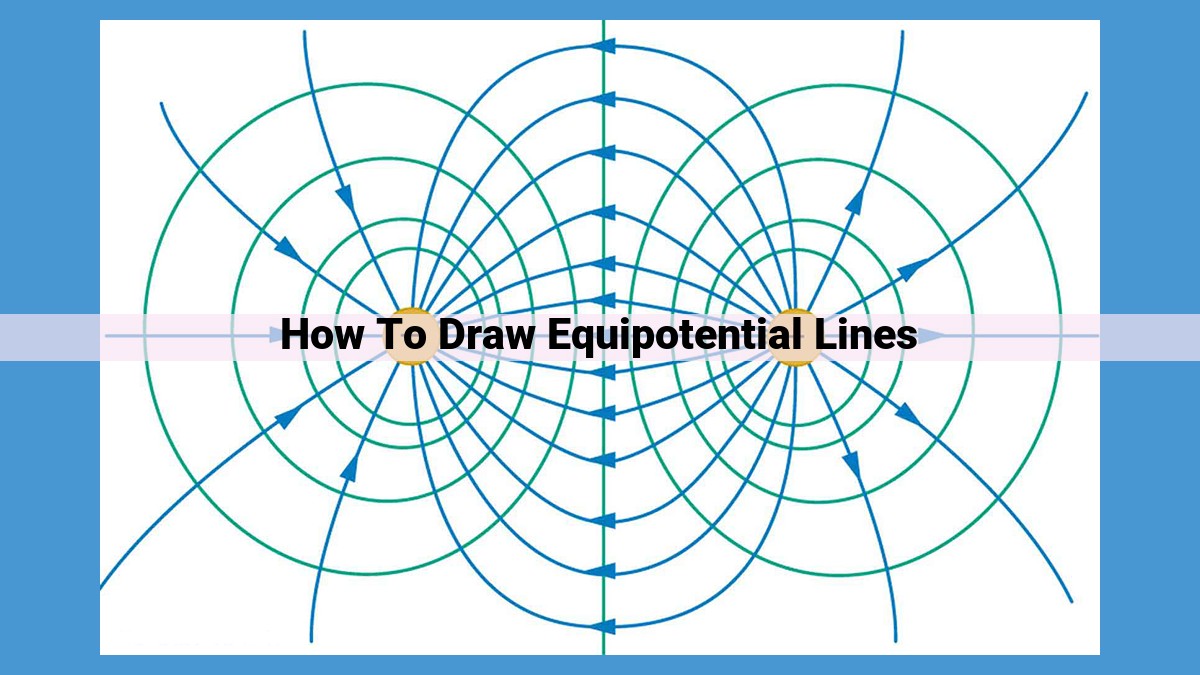To draw equipotential lines, first understand their representation of electric potential, which is constant along each line. They are perpendicular to electric field lines, indicating the direction of the electric force. To draw equipotential lines around a positive charge, start with a point close to the charge and draw a curve perpendicular to the electric field line passing through that point. Repeat this process for other points, creating concentric circles around the charge. Lines closer to the charge represent higher potential, while lines farther away represent lower potential. Remember, equipotential lines never intersect, which helps determine the distribution of charges in the field.
Understanding Equipotential Lines
Imagine a landscape filled with gently sloping hills. Each point on this landscape has a specific elevation, representing its height above sea level. Similarly, in the realm of electric fields, we have equipotential lines – imaginary lines that connect points with the same electric potential.
Electric Potential
Electric potential, often denoted by “V”, is a measure of the electrical energy per unit charge at a given point in space. It’s like the altitude of our hypothetical landscape, indicating the potential for electrical work to be done.
Equipotential Lines
Equipotential lines are like the contours on a topographic map, connecting points with the same elevation. In the electrical context, they connect points with the same electric potential. Imagine walking along one of these lines – you’ll neither gain nor lose electrical potential because you’re staying at the same “altitude.”
Relationship to Electric Field Lines
Equipotential lines are closely related to electric field lines, which represent the direction and strength of an electric field. Equipotential lines are always perpendicular to electric field lines, indicating that an electric force will never cause a charge to move along an equipotential line. Instead, electric field lines point towards regions of lower electric potential, guiding charges down the electrical “slopes.”
Drawing Equipotential Lines: A Comprehensive Guide for Beginners
Understanding equipotential lines is crucial for comprehending the behavior of electric fields. These lines represent points in space where electric potential is constant. Imagine a map of an electric field, where each point on the map has a specific numerical value representing the electric potential. Equipotential lines connect points with the same electric potential value, creating a visual representation of the electric field strength.
Procedure for Drawing Equipotential Lines
To draw equipotential lines around a positive charge, follow these steps:
- Identify the positive charge: Determine the location of the positive charge creating the electric field.
- Choose a reference point: Select a point far away from the positive charge, where the electric potential is zero.
- Draw the first equipotential line: Draw a circle centered at the reference point with a small radius. This line represents the zero electric potential line.
- Draw subsequent equipotential lines: Draw additional circles centered at the positive charge with increasing radii. Each circle represents an equipotential line with a higher electric potential than the previous one.
- Connect the equipotential lines: Smoothly connect the circles to form equipotential lines. These lines should be parallel to each other and form concentric circles around the positive charge.
Concentric Circles and Equipotential Lines
Concentric circles are useful for drawing equipotential lines because the electric field strength around a point charge is radially symmetric. This means that the electric field strength at any given point depends only on the distance from the charge, not on the direction. As a result, the equipotential lines around a point charge form concentric circles, with the positive charge at the center.
By understanding the properties and techniques of drawing equipotential lines, you can visualize and analyze electric fields, aiding in your comprehension of electromagnetism and its applications.
Properties of Equipotential Lines
Perpendicularity
Equipotential lines are perpendicular to electric field lines. This means that, at any point on an equipotential line, the electric field vector is perpendicular to the line. This is because equipotential lines represent points of equal electric potential, and the electric field lines point in the direction of decreasing potential.
Intersection Rule
The intersection rule states that equipotential lines never intersect. This is because, if they intersected, there would be two different points at the same potential, which is not possible. Therefore, equipotential lines must always run parallel or perpendicular to each other.
The intersection rule has important implications for electric charge distribution. For example, if equipotential lines are crowded together, it means that the electric field is strong in that region. Conversely, if equipotential lines are spread out, it means that the electric field is weak in that region. By observing the distribution of equipotential lines, we can infer the distribution of electric charges in a region.
